Fall-Apart Roasted Pork Shoulder with Rosemary, Mustard and Garlic
on Oct 18, 2019, Updated May 13, 2021
This post may contain affiliate links. Please read our disclosure policy.
A super tender slow-cooked marinated pork shoulder or butt roast recipe that is amazing on its own, and also can be used in so many ways. One of my go-to dishes for casual crowd entertaining.
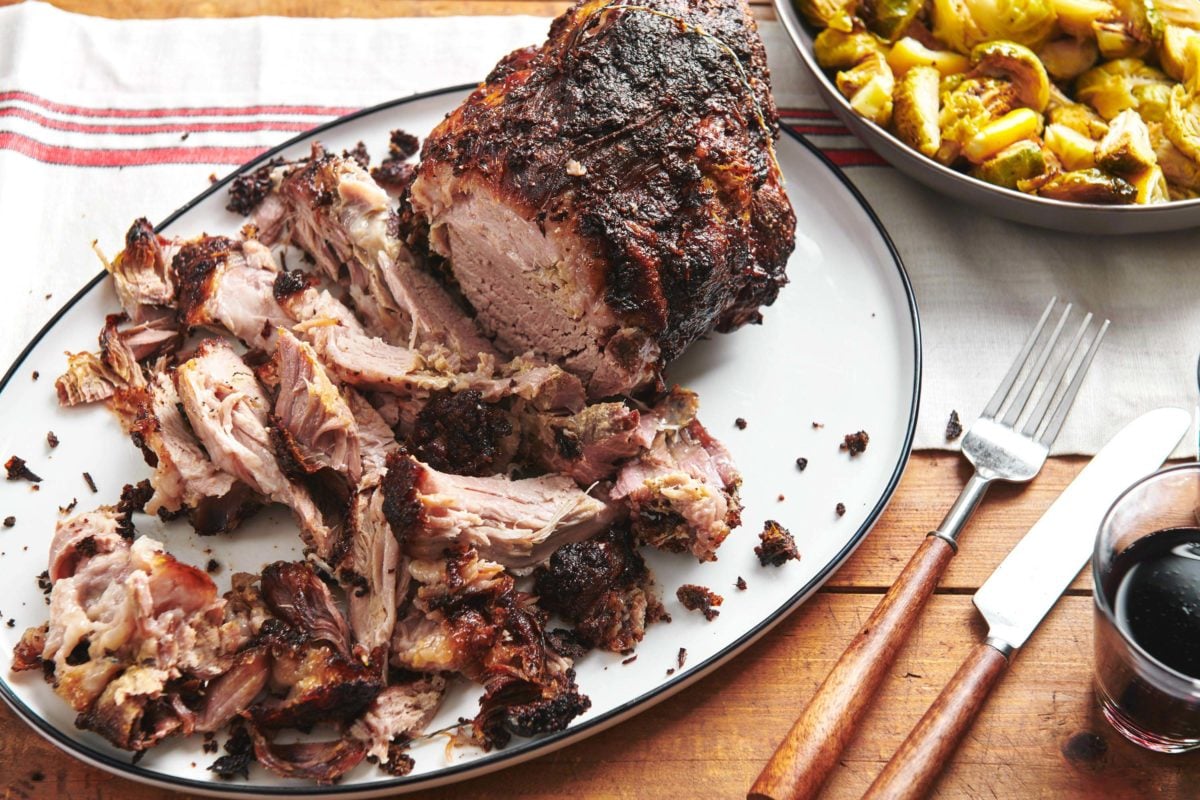
Best Pork Shoulder Roast
I was talking with my friend Chris about perfect meals for entertaining, and we went though the usual suspects: lasagnas, chili, tenderloins, and then he mentioned to me that his favorite go-to entertaining dish was a pork butt or shoulder. We talked about the best way to cook a pork shoulder roast: basically just letting it slow cook in the oven for ages at a very low temperature so that it practically falls apart.
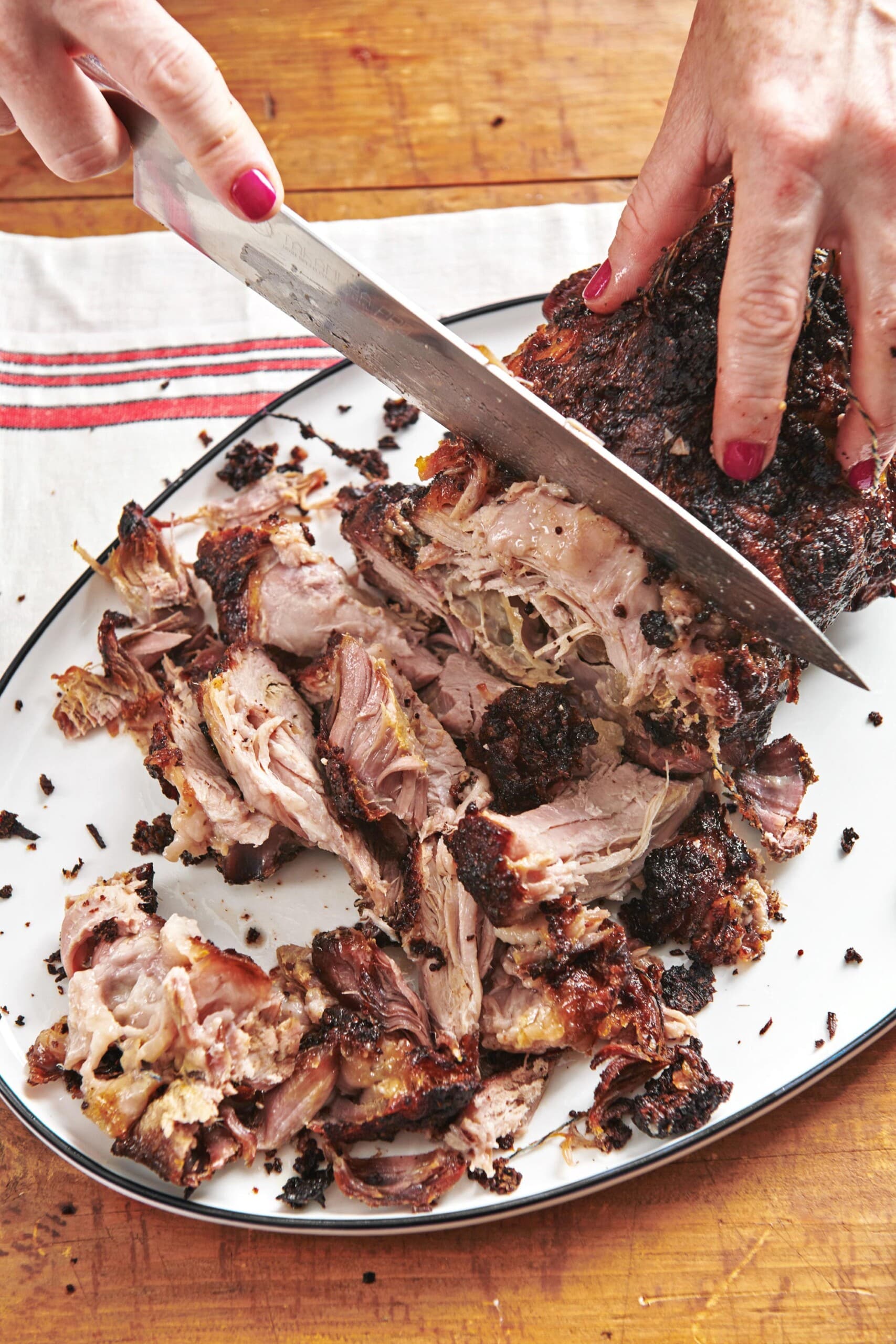
How to Cook Pork Shoulder Roast
Chris told me that long ago a chef has explained to him that meat likes to be cooked at around the temperature that it reached when it is done.
By signing up, you agree to our Privacy Policy.
While I don’t think that is always the case at all (flame kissed steaks and burgers anyone?), it made nice sense when I thought about it in terms of a big tough hunk of meat, like this boneless pork shoulder roast, which needs low and slow cooking to make it turn from impossibly tough to tender. No amount of trying to rush the process will help, you’ve got to keep the heat low and the time long.
Pork Butt Roast
You can also make this recipe and others like it with a pork butt roast or Boston Butt pork roast, which are actually also from the shoulder area, a little further up, but essentially a similar cut of meat.
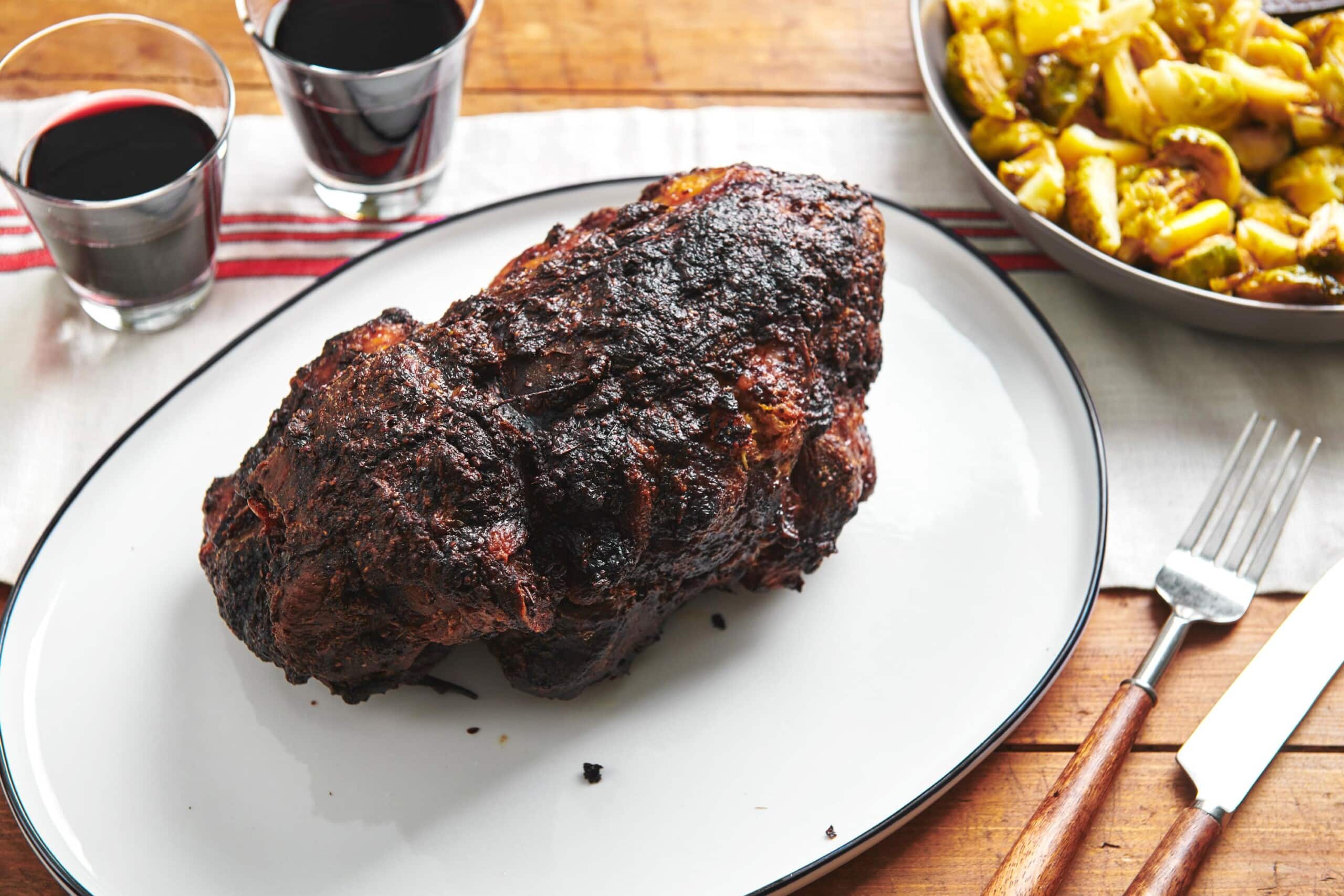
Slow Cooking Pork in Oven
When you slow cook pork shoulder in the oven, boneless or bone-in, you have a lot of flexibility, which is a delightful thing when entertaining. In fact, the cooking time at this low temp could be stretched by an hour or two, and the roast wouldn’t be any worse for the wear. So you can literally plunk it on the table whenever everyone is ready to eat.
Fat Side Down or Up?
And even though this recipe calls for boneless pork shoulder, which is a bit easier to cut, you can use bone-in pork shoulder which will cook in about the same amount of time. The instructions call for the fat side to be down in the pan, which give the top the chance to get a nice crust, but it really doesn’t matter. Some people like the fat on the top, which kind of bastes the pork as it cooks, but then you have less crusty surface. Your call, you won’t go wrong.
The best part? This is free time you can spend reading, dancing, sleeping, cleaning a closet, saving kittens from trees.

A super tender slow cooked marinated pork shoulder roast recipe that is amazing on its own, and also can be used in so many ways.
Low and Slow and Flexible
The flexibility of this recipe bears repeating, because it’s one of the best things about this dish. You can leave the roast in the very low oven for another hour or two or even three with no repercussions. The pork is roasted uncovered so that it gets a wonderful crusty brown exterior, while the inside becomes fall-apart tender.
If you feel like it needs a bit more browning or caramelization at the end, turn the heat up to 450°F. for 15 minutes before pulling it out of the oven. Make sure to let it rest for a bit so that the fibers can relax a bit, and the juices re-group.
And do know that if all has gone as planned, the meat will be so tender that the slices won’t hold together. That’s part of the appeal.

For a Smaller Pork Shoulder Roast
If your roast is smaller than 6 pounds, you can still use the recipe fully successfully, just shorten the cooking time slightly. You still want to start it at high heat, in a preheated 450°F oven. Roast the pork for 20 minutes, then turn the heat down to 250°F and continue to cook for 4 to 7 hours until the middle of the roast registers 180°F on an internal thermometer, and as you slide the thermometer in you can feel that the meat is very tender throughout.
- For a 3 pound pork roast, start with the heat at 450° for 20 minutes, then turn the heat down to 250°F and continue to cook for 4 to 5 hours until the middle of the roast registers 180°F.
- 4 pound pork roast: Start with the heat at 450° for 20 minutes, then turn the heat down to 250°F and continue to cook for 4 1/2 to 5 1/2 hours until the middle of the roast registers 180°F.
- 5 pound pork roast: Start with the heat at 450° for 20 minutes, then turn the heat down to 250°F and continue to cook for 5 1/2 to 7 hours until the middle of the roast registers 180°F.
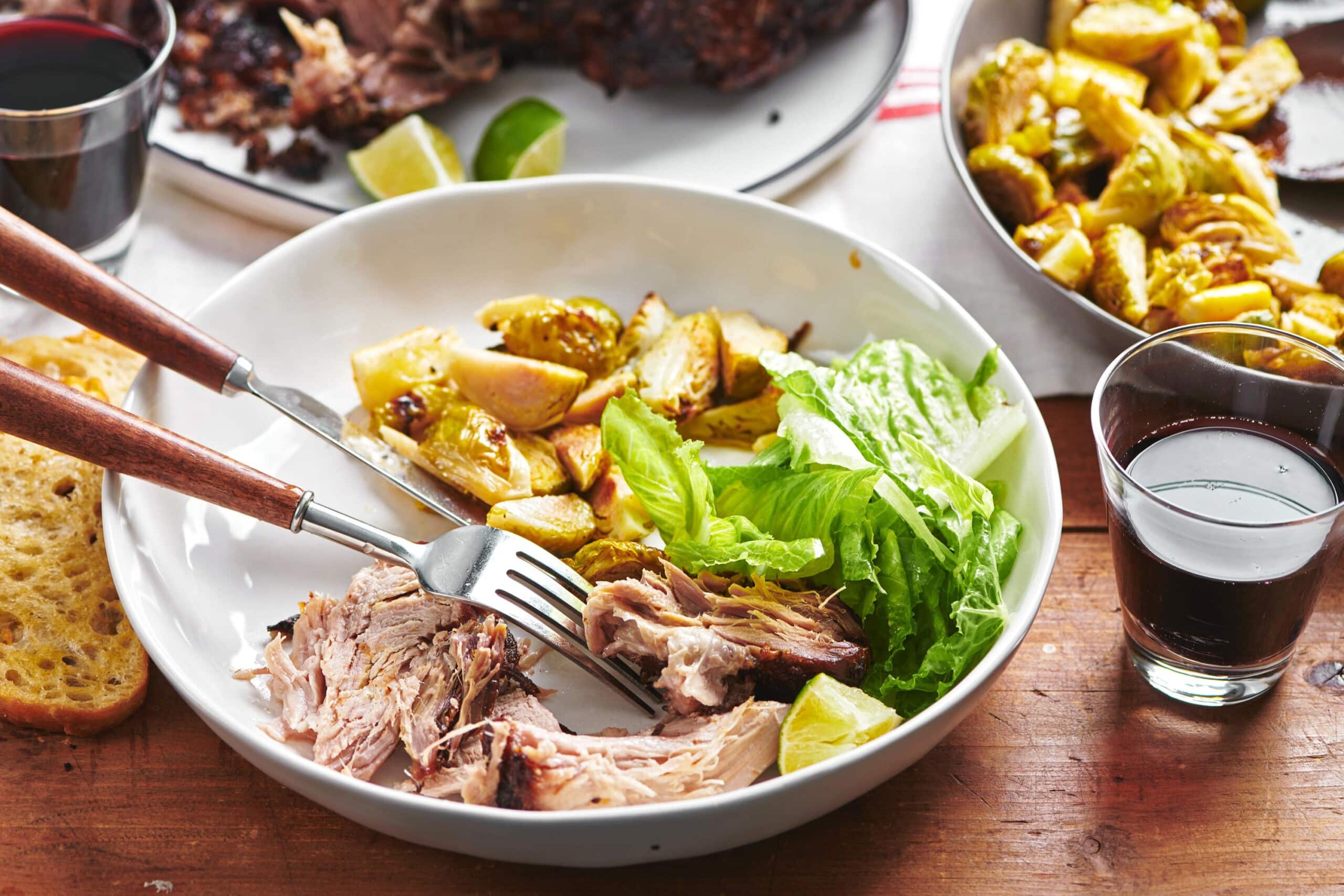
For a Larger Pork Shoulder Roast
A larger pork roast still starts with a short burst of high heat roasting, then is cooked low and slow for a longer amount of time. Again, you want the meat to be falling apart tender. Every piece or pork and every oven is different, so use the below time ranges as a guideline, start checking at the shorter end of the cooking time, and if you need to let it go longer to get tender, that’s fine. Once it begins to get tender check every 30 minutes until it is fully tender and falling apart.
For anything larger than a 6 pound roast, you will want to add another half of the marinade ingredients to the blend. If you have a 10 pound or larger roast, you’ll want to double the marinade.
- 7 pound pork roast: Start with the heat at 450° for 20 minutes, then turn the heat down to 250°F and continue to cook for 7 to 8 1/2 hours until the middle of the roast registers 180°F.
- 8 pound pork roast: Start with the heat at 450° for 20 minutes, then turn the heat down to 250°F and continue to cook for 7 1/2 to 8 1/2 hours until the middle of the roast registers 180°F.
- 9 pound pork roast: Start with the heat at 450° for 20 minutes, then turn the heat down to 250°F and continue to cook for 8 to 10 hours until the middle of the roast registers 180°F.
- 10 pound pork roast: Start with the heat at 450° for 20 minutes, then turn the heat down to 250°F and continue to cook for 8 1/2 to 10 1/2 hours until the middle of the roast registers 180°F.
Substitutions for Anchovies
I fully recommend the use of anchovies in the marinade, which don’t add any kind of strong fishy flavor, but rather a depth of overall flavor which I promise won’t taste like anchovies. If you don’t have them, or don’t want to use them, you can sub in 2 teaspoons fish sauce, 3 teaspoons minced capers, or even 2 teaspoons soy sauce.

What to Serve with Pork Shoulder Roast:
Leftovers are brilliant. So endlessly useful to make amazing quesadillas, enchiladas, burritos, soups, stews, sandwiches, and so on.
Serve Fall-Apart Roasted Pork Shoulder with Rosemary, Mustard and Garlic with:
- Green Beans and Mushrooms with Shallots
- Roasted potatoes
- A green salad
- Cole slaw
- Spoonbread Corn Pudding
- Mashed Sweet Potatoes with Roasted Garlic.
- Warm Brussels Sprouts with Anchovy Vinaigrette
Other Pork Recipes:
- Pernil
- Bourbon Brown Sugar Pork Loin
- Slow Cooked Pork Roast
- Dijon and Honey Crusted Pork Tenderloins
- 2-Ingredient Slow Cooker BBQ Pulled Pork
- Slow Cooker Barbecue Pulled Pork Loin
Pin this now to find it later
Pin It
Fall-Apart Roasted Pork Shoulder with Rosemary, Mustard, and Garlic
Video
Ingredients
- 2 tablespoons chopped garlic
- 3 anchovies (rinsed)
- 2 tablespoons chopped fresh rosemary
- 2 teaspoons kosher salt
- 1 teaspoon freshly ground black pepper
- ¼ cup olive oil
- 2 tablespoons coarse Dijon mustard
- 1 (6-pound) boneless pork shoulder (trimmed of excess fat and tied)
Instructions
- In a small food processor, combine the garlic, anchovies, rosemary, salt, and pepper. Add the olive oil and process until it forms a paste, scraping down the sides. Remove the blade and use a fork or spoon to stir in the mustard. Rub the paste all over the pork shoulder, loosely cover it with plastic wrap, and refrigerate from 2 to 24 hours.
- Preheat the oven to 450 F and bring the pork to room temperature while the oven heats. Place the pork in a shallow roasting pan and roast, uncovered, for 30 minutes, until the top starts to brown a bit. Turn the heat down to 250 F and continue to cook, uncovered, for 6 to 8 hours until the middle of the roast registers 180 F on an internal thermometer, and as you slide the thermometer in you can feel that the meat is very tender throughout. If juices are in the pan (and I have found that sometimes there are and sometimes none), pour off the juices from the pan into a heatproof container, like a Pyrex measuring cup. Place this in the fridge, where the fat will rise to the top, while the meat rests.
- When the meat is cooked, if you think that the outside of the roast could use a bit more crust/brownness, turn the heat back up to 450 F and let it cook for another 15 to 20 minutes to give the outside a bit more of a crunchy texture.
- Remove from the oven and let sit for about 20 minutes. Spoon the fat off the reserved juices in the fridge and pour the cooking juices into a serving pitcher or bowl (warm it a bit in the microwave or in a small pot if you like). Slice the pork as thinly or thickly as you like, knowing the meat will fall apart at least slightly. Sprinkle the sliced meat with a bit of salt before serving, and pass the pan juices on the side to drizzle over.
Notes
- You can also make this recipe and others like it with a pork butt roast or Boston Butt pork roast. These are actually also from the shoulder area, a little further up, but essentially a similar cut of meat.
- I fully recommend the use of anchovies in the marinade, which don’t add any kind of strong fishy flavor, but rather a depth of overall flavor which I promise won’t taste like anchovies. If you don’t have them or don’t want to use them, you can sub in 2 teaspoons fish sauce, 3 teaspoons minced capers, or even 2 teaspoons soy sauce.
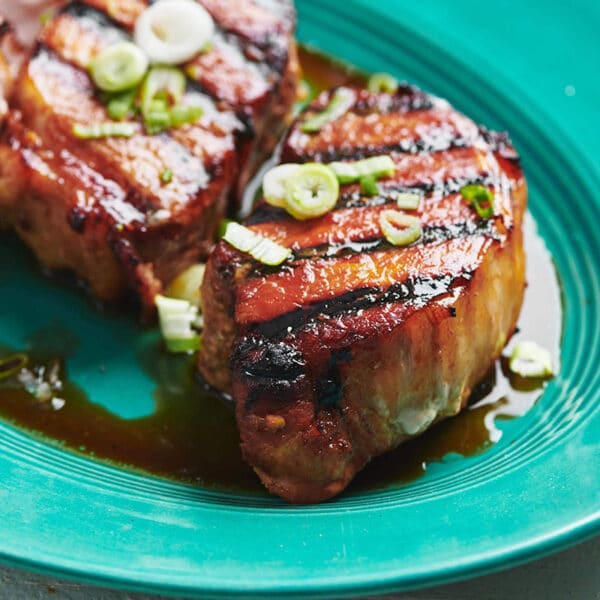
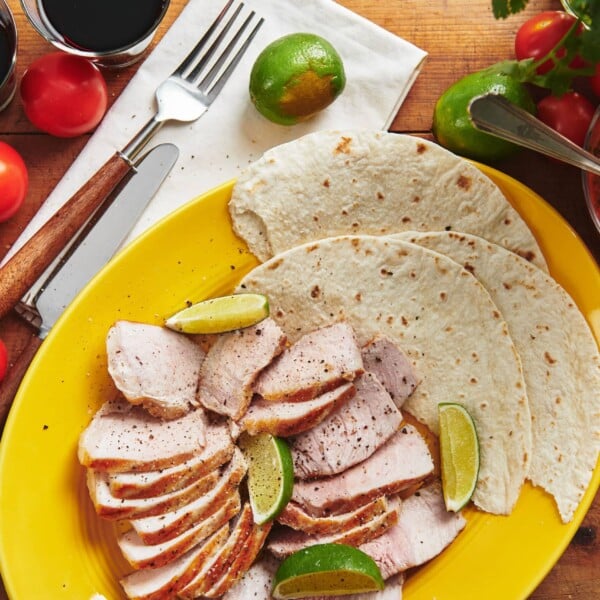
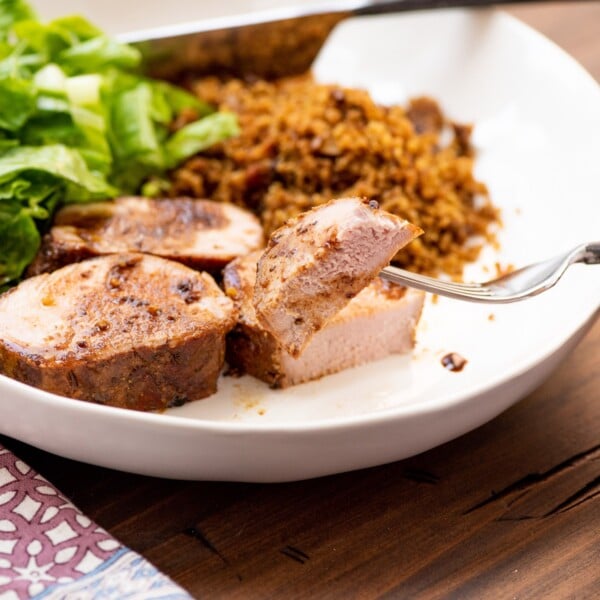










Have you tried making this in a crock pot?
it can definitely be made in a crock pot – you won’t get as much texture, and I would probably sear it before putting in in the slow cooker, but you can cook it on low for 8 hours!
Why not put the pork shoulder roast in a crock pot for slow cooking? What difference does the oven make? Is it because the oven is a dry heat?
exactly – you will end up with very tender but not wet meat inside, and a terrific crust when you cook it this way.
This pork roast recipe is very good. Pork roast is a “Sunday dinner” favorite of mine since childhood. I make it a lot in fall and winter. I read this recipe and decided to try it. This marinade is quite flavorful. The oven method of starting at a high temp, then going low and slow works well with pork shoulder. The only variance I made was slicing a large yellow onion in thick slices, placed them in the bottom of my roasting pan for the roast to rest on. Then poured a little chicken stock in the pan to about half way up the onion slices. After skimming the fat, the drippings were delicious in my gravy.
Note: I used a nine pound bone in pork roast. The recipe states to cook for eight to ten hours at 250 degrees. I questioned this and set my timer for only six hours, with the thought of checking for doneness at that point. (I do not like over cooked, dried out meat.) After six hours, my roast was perfectly fall apart tender. The top fat had melted down beautifully. One star reduction due to timing issue. Eight to ten hours would’ve rendered this roast inedible.
Wow I’m so happy to have read your review before making my 9 lb. butt roast because I was also worried about the length if time needed to cook my roast today & concerned about overcooking it’s as well !!!!!!!
I had planned on cooking it overnight but now I’ll cook it during the day in order to keep an eye on it closely!!! I’m currently brining it in your basic salt/sugar solution in fridge for about 3-4 hours. Thanks again!!!!
Great recipe; key points Do NOT Miss –
>Low and Slow is the way to go ! Don’t rush the roast
>Season ahead and Rest – really makes the flavor (I chose a more neutral flavoring knowing I would have leftovers) (I would say this is the only optional step if you must skip one.)
>Bring roast to room temp before cooking, allows the roast cooking time to be more precise
>20 min on High (I did fat side up ) then 7 hours on low for my big roast – then a blast of heat at last
>Rest for 20 before cutting allows for a better cut.
>Skim the fat – use the pan drippings – I used a mushroom base and flour to make an Fabulous Gravy
That is literally everything she said.
Turned out perfectly!!! I subbed with capers b/c I didn’t have anchovies. So yummy~ thanks for the recipe!
This is the BEST recipe … made it today and I have never tasted such amazing flavours… the anchovies absolutely add a punch to this. Thanks so much for sharing
Great recipe, and really seems fool-proof! I didn’t have anchovies, so used a combination of Worcestershire and soy, as was suggested. I had a huge 10 pounder and I cooked for 9.5 hours after the initial blast. It was incredible! I do prefer the fat side up, so I did it that way. Lastly, I made a traditional gravy using some of the fat for the roux and then the separated broth/drippings supplemented with some beef broth. The seasonings from the marinade gave the gravy tremendous flavor. Shredded the pork (with some little crispy fat bits) and served over garlic mashed with the gravy. Holy comfort food!
holy comfort food indeed!!!!
I adore this recipe. I’ve made it about a dozen times and guests are always amazed at how delicious it is. My only modification is that I make gravy from the drippings by skimming off most fat, stirring in a couple tablespoons of flour over heat, and whisking in a couple cups of chicken stock until thickened.
One of the great things about the recipe is the leftovers. They’re great just reheated, but also can be transformed into a second delicious dinner. Today, I used 2 pounds of leftover cooked pork in the NY Times’ chicken tinga tacos recipe (instead of chicken thighs). I added some chicken stock and cut cooking time in half. It is easy and the best taco I’ve ever had. I’ve also made the leftover pork into filling for green chili burritos, which is very easy and very good.
Excellent. We will prepare again this winter.
Possibly the best piece of meat I’ve made. Very similar to a traditional German pork knuckle that I have been trying to mimic.
love hearing that!